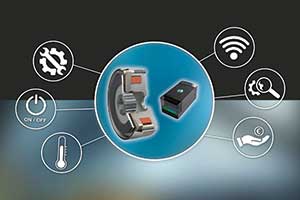
Posted to News on 23rd Sep 2020, 00:00
Networked brakes turn machines into smart robots
Be it an industrial robot or the servo axes in a medical machine, moved loads must not drop or crash in an uncontrolled manner after power switch-off or in the case of power failure or an emergency stop. With a combination of technically leading brake technology and innovative monitoring solutions, the hurdles can be overcome and robots made smarter.

Robots are gaining ground. In all important industrial sectors, the cooperation between humans and robots is becoming increasingly closer. This increases the risk potential. If, for example, a power failure occurs during a working process, the robot arm undertaking the working step must be held immediately and accurately. Therefore, it is important to permanently exclude the risk of an inadvertent descent of the load as well as unpermittedly long stopping distances already in the design phase.
Decisive for this purpose are the correct selection of safety brakes as well as their proper integration into the overall system. Safety brakes according to the fail-safe principle are the first choice for servomotors, as these brakes are closed in de-energised condition. They provide the required braking torque even in the event of an emergency stop, a power failure or in case of an interruption in the power supply caused by cable breakage, for example. To ensure that the safety brakes also provide sufficient friction work in emergency stop situations and brake movements with a defined braking torque, a friction lining developed for this purpose with a corresponding steel counter friction surface is required.
There are safety brakes for servomotors which are specially adapted to the high requirements of robotics. Users can choose between classic servo brakes in the motor, with hub and toothed rotor or so-called pad solutions with large inner diameter. The latter are specially designed for integration into the robot joint. But even the classic brakes can be adapted to customer specifications and integrated directly into a joint. In the motor, servo brakes are preferably installed into the A-bearing shield, because the fixed bearing is located here and temperature expansions cannot influence the brake severely.
However, brakes from renowned manufacturers can also be integrated into the B-bearing side of the motor without restriction, as here temperature expansions and bearing backlash do not influence the function and reliability of the brakes negatively. Alternatively, users can also make use of mounted brakes, which are attached to the motor in a modular fashion. High-quality servo brakes are also characterized by compact dimensions. Not only are they very lightweight, but also extremely fast when it comes to magnetic actuation. At the same time they display high performance density and wear resistance.
Furthermore, the brakes impress users with their high permitted friction work during dynamic braking actions: For servo drives, normally load mass ratios (load/motor) of 3:1 or smaller are selected for the benefit of good control characteristics and high dynamics. On the brakes of renowned manufacturers, high permitted friction work and friction powers mean that load mass ratios of 30:1 and more are possible.
Short switching times
Short stopping distances are important for the safety of people and machines. The brake switching times are decisive for the braking distance, because during the free-fall time until the brake closes and the retardation takes effect, the mass additionally accelerates – possibly to such extremes that the permitted values of the brake are exceeded. Users should therefore pay attention to verified switching times which are as short as possible when selecting safety brakes – and also assure themselves that these switching times can be maintained throughout the entire lifetime of the brake.
Here, monitoring solutions are important. Previously it was not possible to monitor servo brakes due to the small air gaps. This is a concern in view of the increasing networking of machines. Of course, the control and regulation electronics of the servo system provide data that also allow conclusions to be drawn regarding the state of the overall system. But the safety brake itself remains silent. Even though in closed systems data from the brake would also be very helpful and would enable, for example, predictive maintenance. If, for instance, the friction lining reaches the end of its service lifetime, intelligent monitoring could provide timely warning. The maintenance date could then be scheduled long-term for a time window that is favourable in terms of the overall operating process. Monitoring is therefore also very useful for these safety brakes integrated in servo drives.
May Power Transmission offers exactly these possibilities with its intelligent Roba-brake-checker module. It works without sensors. Instead, it detects the movement of the armature disk by analysing current and voltage, and knows what condition the brake is in. From the control cabinet. In addition to the switching condition, temperature and wear, it monitors the tension path or tensile force reserve, ie whether the magnet is still able to attract the armature disk.
On reaching the tensile force reserve, the Roba-brake-checker emits a warning signal early enough so that a certain operating time for the brake is still possible. During this time, maintenance is possible in a targeted manner, aligned to the working process. This in turn ensures higher system availability. In a further expansion stage, the module can also be integrated into a remote maintenance system via a suitable interface. This further reduces service times and costs.
If damage should occur nevertheless, the Roba-brake-checker provides users with significantly better analysis options. With previous solutions, such as contactless release monitoring, users are only able to see the failure and the destruction pattern. They do not know, however, why the error occurred. However, using the Roba-brake-checker, progressions are made visible and error analysis can be used and even transferred onto other user systems. All this data from malfunctions and normal operation thus supply valuable input for future optimisation.
To guarantee that the brakes always ensure the highest level of safety in the respective application, it is important that the static and dynamic braking torques correspond to the respective customer specifications. For this purpose, it is necessary to check these two application conditions in trials. Therefore, it is highly recommended that users obtain information about the manufacturer’s test field, and question whether the brakes are subjected to tests that are as realistic as possible.
In addition to quality assurance measures during the construction process, a manufacturer should also carry out a comprehensive final inspection. This means that every single safety brake which leaves the plant is subjected to a 100% inspection following assembly and adjustment. At Mayr, all the determined measurement values are archived together with the corresponding serial numbers of the brake in an electronic database. Only in this way 100% traceability can be ensured.
10/11 Valley Road Business Park
Valley Road
BD21 4LZ
UNITED KINGDOM
+44 (0)1535 663900








